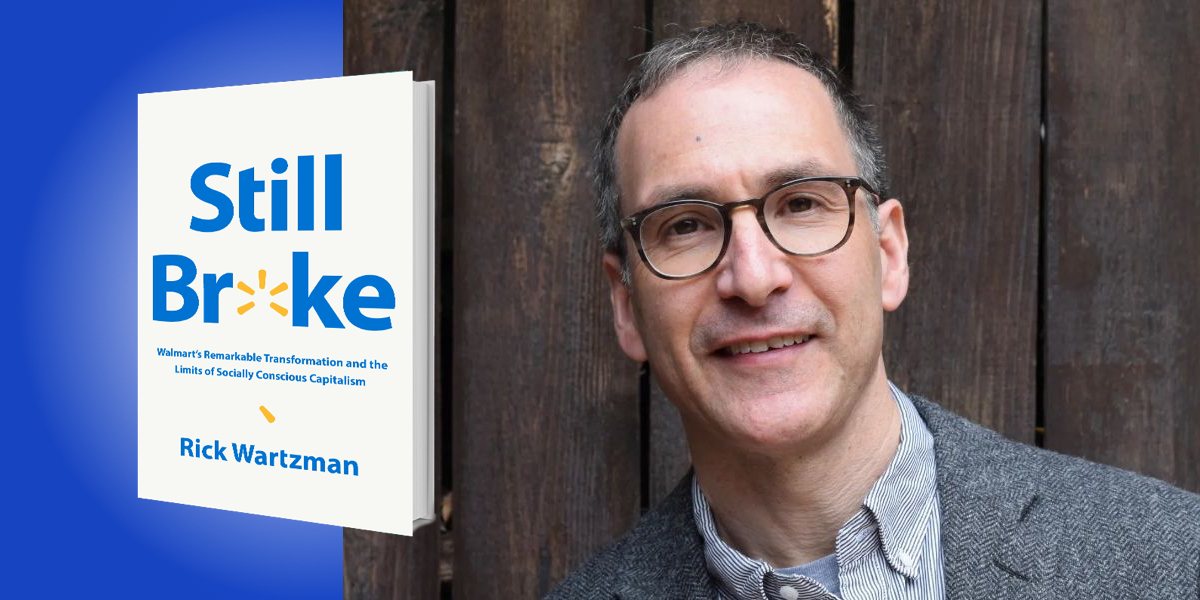Rick Wartzman is a journalist, editor and director of the KH Moon Center for a Functioning Society at the Drucker Institute, a part of Claremont Graduate University. He writes about the world of work for Fortune magazine online and worked as a reporter and editor for The Wall Street Journal and the Los Angeles Times for two decades. While business editor of The Times, he helped shape a three-part series on Wal-Mart’s impact on the economy and society, which won the 2004 Pulitzer Prize for National Reporting.
Below, Rick shares 5 key insights from his new book, Still Broke: Walmart’s Remarkable Transformation and the Limits of Socially Conscious Capitalism. Listen to the audio version—read by Rick himself—in the Next Big Idea App.
1. Walmart is no longer the evil empire.
For about a decade and a half beginning in 2000, Walmart was routinely portrayed as greedy, if not downright malevolent. “If you really—we mean really—want to scare the locals next Halloween, here’s an early costume idea for you or your kids: dress up as Walmart,” two commentators wrote in 2008. Tellingly, this zinger didn’t come from a pair of union backers or liberal pols. It was served up by two officials from the Federal Reserve Bank.
Walmart was blamed for all sorts of ills: killing off Main Street mom-and-pop businesses, driving U.S. manufacturing overseas, and above all, mistreating its frontline workers. Many folks won’t step into a Walmart to this day.
Over the years though, Walmart has taken a number of steps that have helped to reform its image. It has become a much greener company—so much so that it is now seen as a corporate environmental and sustainability leader. It has given away billions of pounds of food to food banks. It has also lowered the price of prescription drugs, making essential medicines more accessible for millions of Americans.
Walmart has also invested in its hourly employees as it never did before. From 2015 through 2021, the company spent $5 billion to $6 billion on higher pay, increased benefits, training, and education for its frontline workers. Its starting pay has gone from an average of $7.65 an hour to a minimum of $12 an hour. The company’s average hourly pay is now over $17 an hour.
“It has become, in many eyes, a paragon of socially-conscious capitalism.”
Walmart has “gone from being seen as a problem to becoming a significant part of the solution,” according to John Streur, the chief executive of Calvert Research and Management, which specializes in socially responsible investing. He is hardly alone in lavishing such praise. When Walmart began to raise its starting pay, the company landed on Fortune magazine’s “Change the World” list. It has become, in many eyes, a paragon of socially-conscious capitalism.
2. Even with all of the progress it has made, Walmart can—and should do more.
Walmart has progress made on many fronts, including the treatment of its frontline workers. Yet even with all of the positive steps it has taken, here’s the bottom line: The average Walmart worker still makes less than $29,000 a year. Too many of its workers are still on food stamps and Medicaid. This is not to make light of the steps that Walmart has taken. In the context of its own history, the company has evolved far more than many others. Its transformation has been real.
However, this is also real: if you work at Walmart, even after everything it has done to improve your job, there’s more than a fair chance that you’ll still be poor. Just because things are better doesn’t mean they’re good. In my view, Walmart—with free cash flow that has averaged about $17.5 billion dollars over the past five years—can do more and should do more. Much more.
3. Walmart is both a source and a symbol and of America’s low-wage crisis.
For those with the temerity to question why Walmart doesn’t pay more, the answer is always some version of “Our wages reflect the local market average for that type of job.” Missing from this is any recognition that the market average has been weak for decades and that Walmart, as the largest employer in the country, has helped to set the standard. As Alison Omens, the chief strategy officer at JUST Capital, which measures and ranks companies on social and environmental impacts, told me: “It becomes a circular argument that Walmart is at the average. Functionally, they are the market.”
“Walmart is also a symbol of something much bigger: a nation beset by a terrible wage crisis.”
Beyond being a source of low-paying work, Walmart is also a symbol of something much bigger: a nation beset by a terrible wage crisis. A 2017 survey of thousands of frontline workers at Disneyland, which bills itself as “The Happiest Place on Earth,” found that more than 10 percent of them had been homeless sometime in the preceding two years. Two-thirds couldn’t afford to eat three meals a day.
Two-thirds of some 10,000 Kroger supermarket workers surveyed in 2021 said they weren’t earning enough to cover their basic expenses each month, with 44 percent reporting that they couldn’t pay their rent and 39 percent unable to afford groceries. On and on it goes, so that—depending on exactly how you measure it—some 25 percent to 40 percent of the U.S. labor force (40 million to 65 million working people) have trouble making ends meet.
4. Walmart (and companies like it) will never do enough on their own.
Both government and business have a vital role to play in making sure that American workers earn a decent living. Previously, my opinions were that government is mainly there to set the guardrails and provide a safety net when someone really needs help and it was up to business to carve up the pie broadly and fairly, as it had in the three decades after World War II.
“Washington’s prod can’t alone turn things around,” I wrote in the past. “Corporate executives must step up…. It is their companies that must reinstitute a sturdier social contract with their workers.” My deep dive into Walmart has caused me to reconsider. Business can and should do more.
What I’ve come to believe now is that unless there is a government mandate, Walmart, and most every other company in America, will never move far enough or fast enough to provide people with a genuine living wage. There are exceptions of course, such as Costco, Bank of America, and PayPal, among other high-profile examples. For most of corporate America, however, Washington’s prod is the only way to get there.
5. We need a government-mandated living wage of $20 an hour.
There is no mystery as to the policies we need to help workers regain their rightful share of the nation’s prosperity. Bold government actions are needed, including reforming labor law and devising a health system that gives every American affordable access to good medical care, untethered to the workplace.
“80 percent of Americans reside in a county where they need to earn at least $20 an hour to support the typical working family.”
More than anything, though, we should require that companies pay their workers enough to live on. What this looks like is also not a mystery. A federally mandated living wage of no less than $20 an hour should be our reality. Why? Because 80 percent of Americans reside in a county where they need to earn at least $20 an hour to support the typical working family, according to Living Wage for US.
This idea of a “family living wage,” it should be noted, is based on widely accepted methodology, used around the world. Many are sure to dismiss $20 an hour as “radical.”
But what is truly radical is this:
- In the richest country on earth, one in six working people can’t come up with the money for their prescription drugs.
- Even before COVID-19, about 30 percent of families with two working adults experienced material hardship such as falling behind on the mortgage or the rent, or medical bills.
- A third of those going to food banks are from a household with at least one member who has been working.
- Nearly half of Americans have only the slimmest of financial cushions and wouldn’t be able to cover their expenses for more than two months if they lost their job
- Homelessness is not just a manifestation of mental health issues and addiction, but also of work that doesn’t pay sufficiently, with more than half of those in shelters and more than 40 percent of those on the streets having had some formal employment in the year they were living under these conditions.
“When it comes to poverty,” Princeton sociologist Matthew Desmond has explained, “a willingness to work is not the problem, and work itself is no longer the solution.” It is high time we change this paradigm.
To listen to the audio version read by author Rick Wartzman, download the Next Big Idea App today:

































